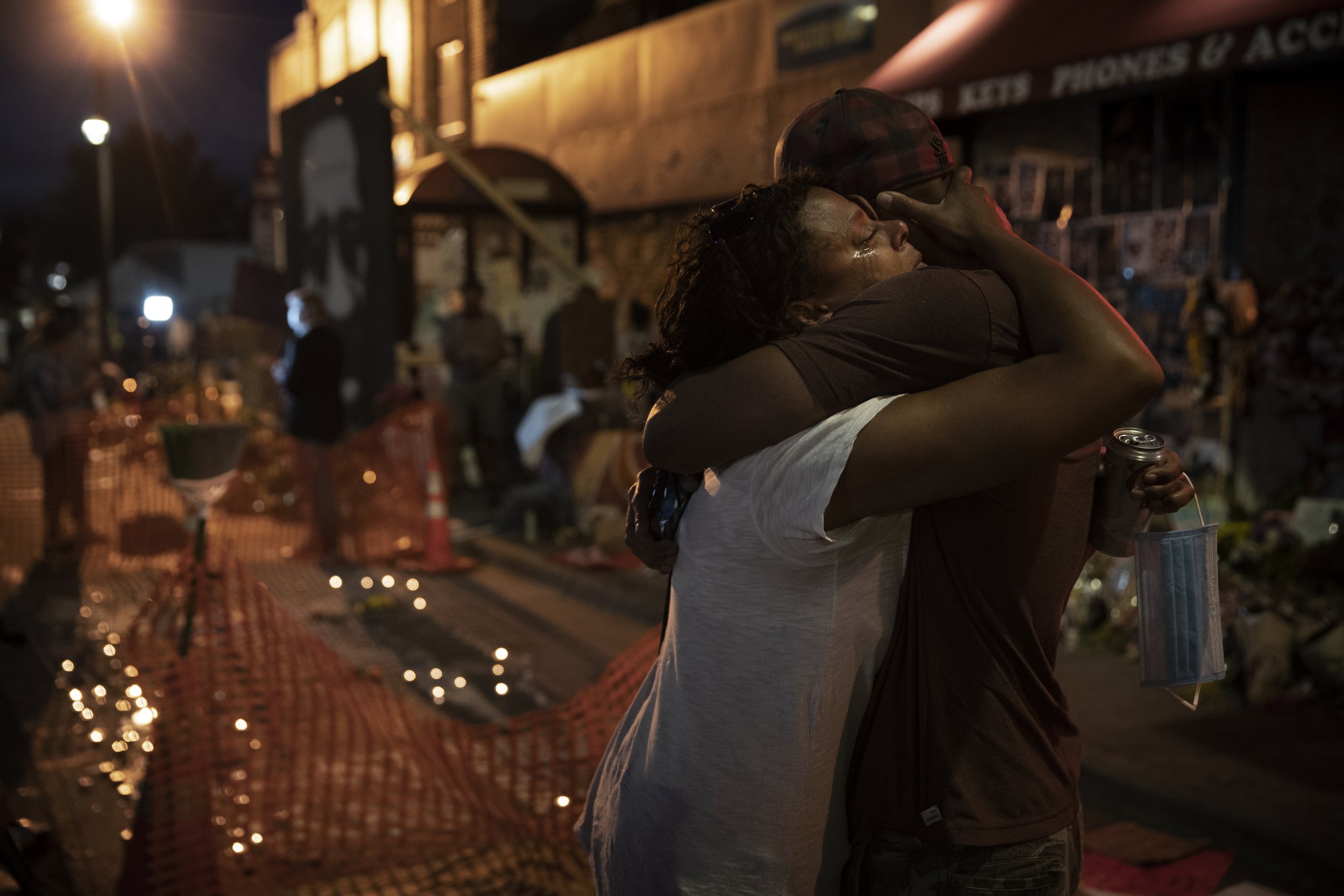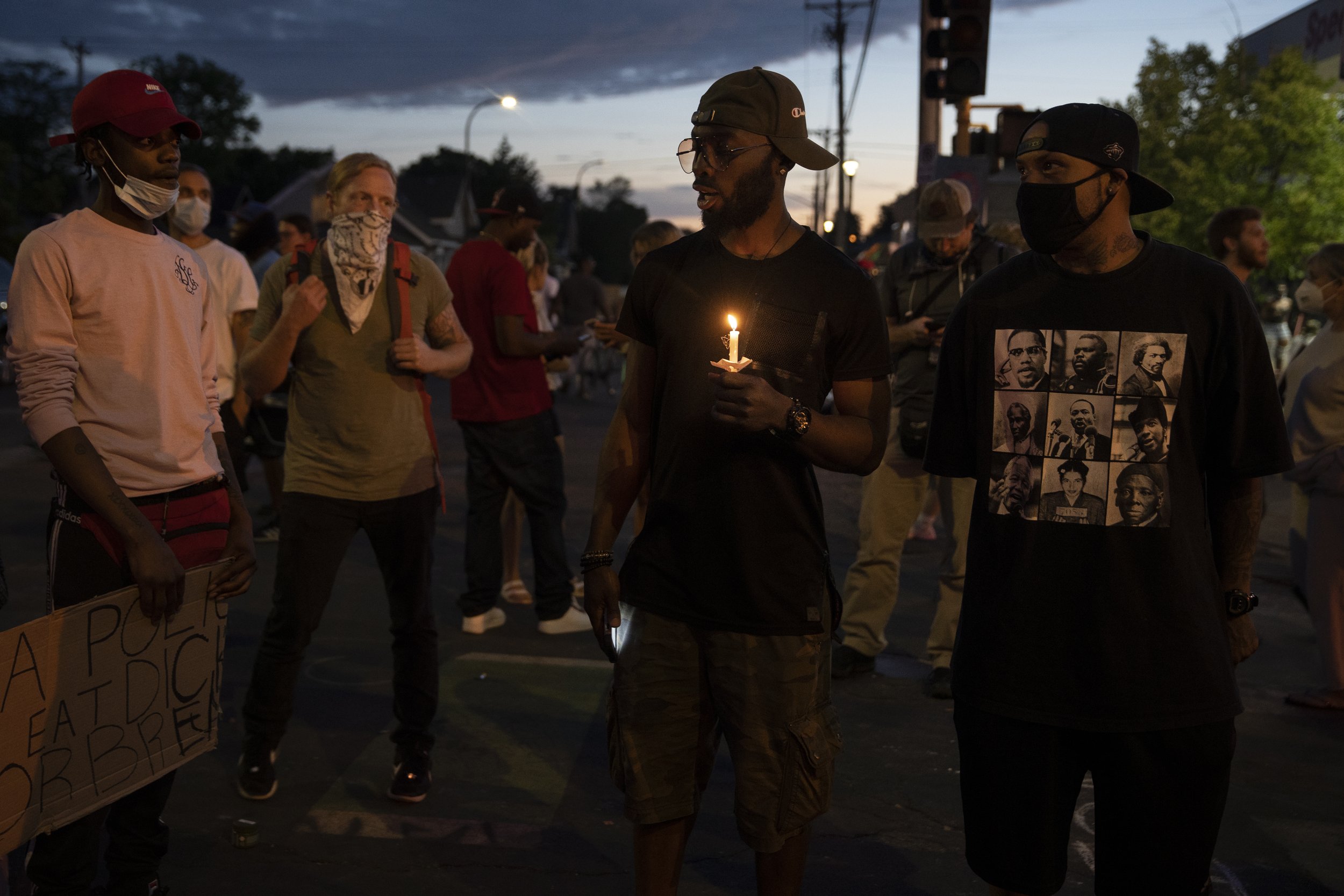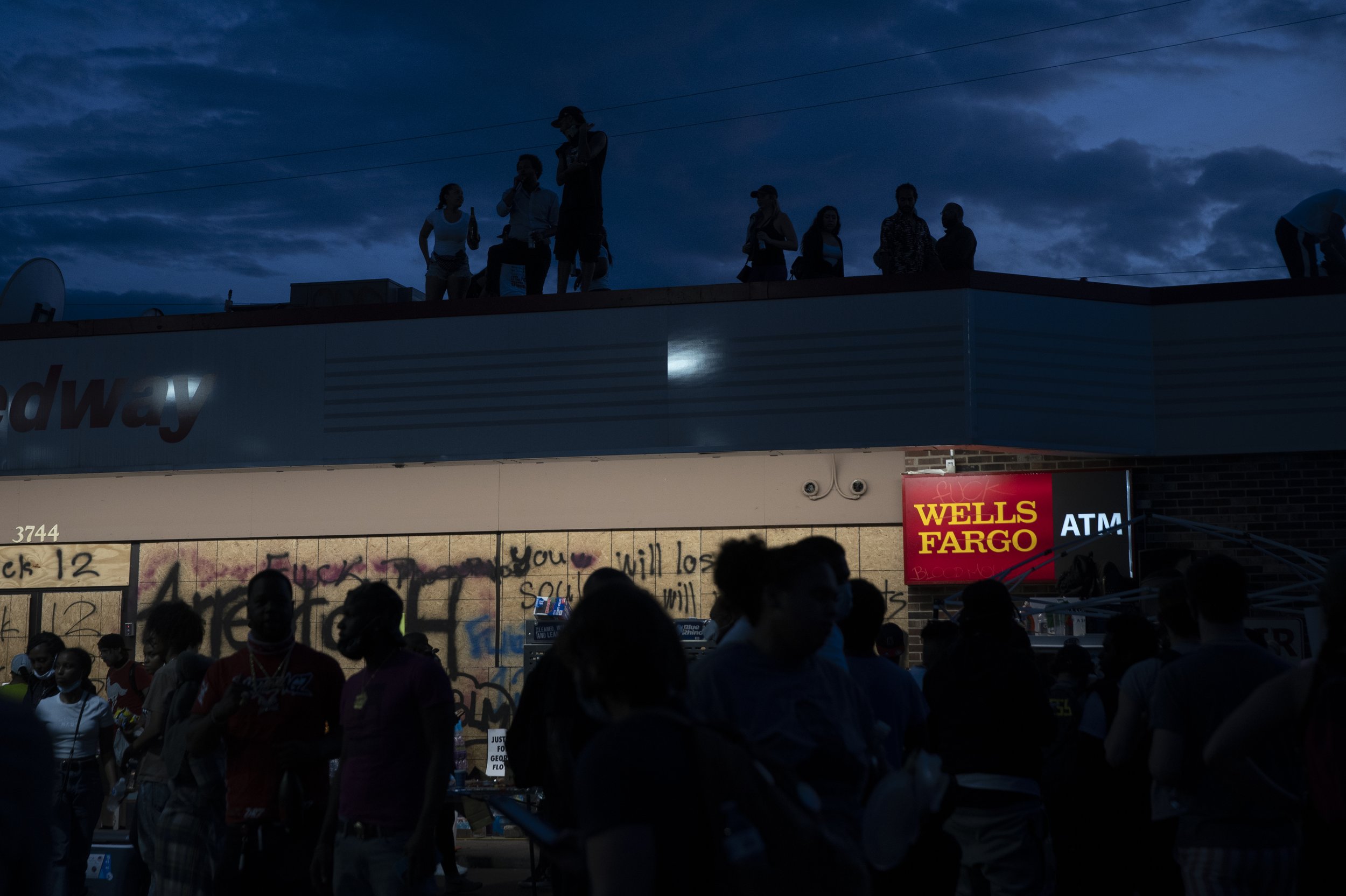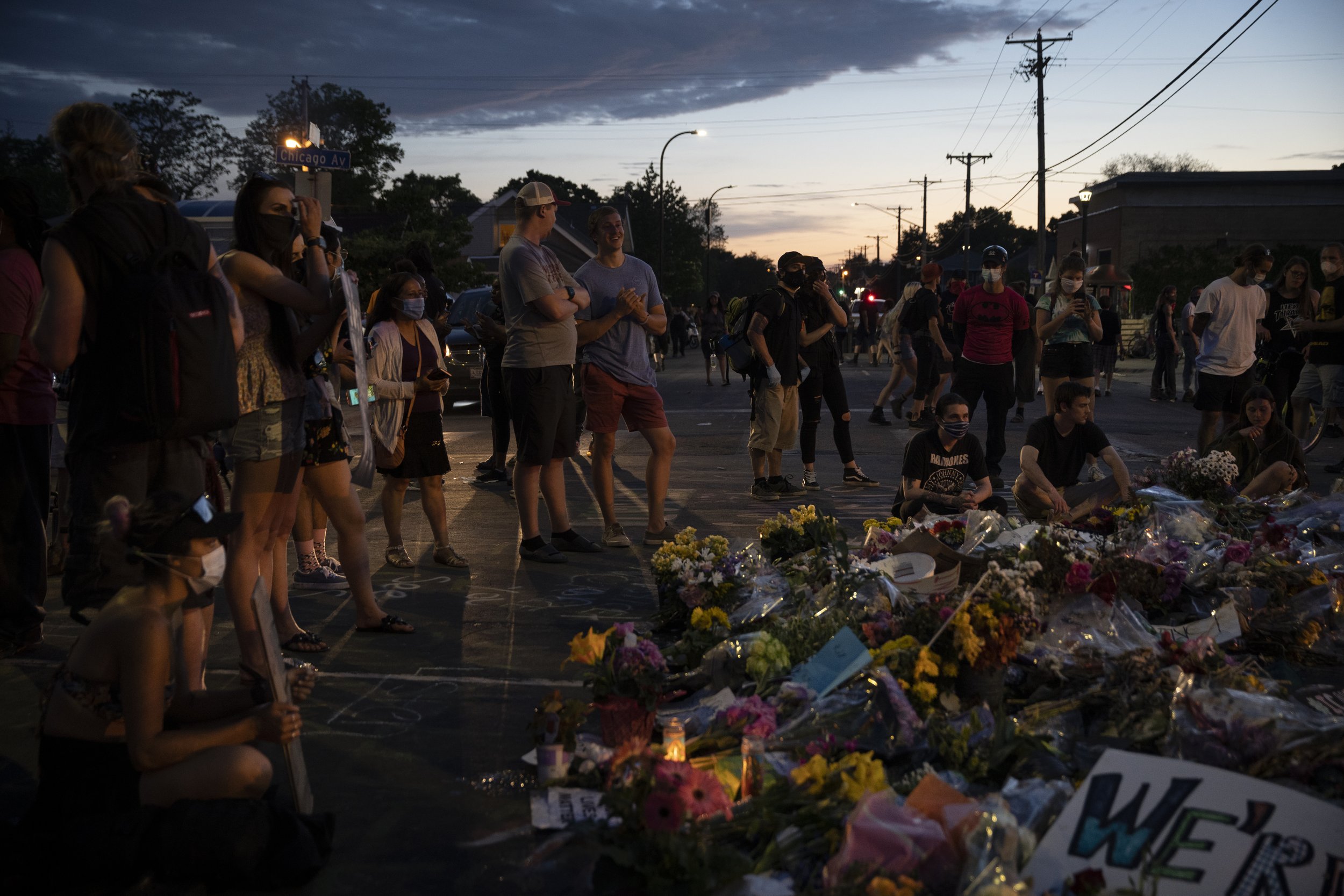The Intersection – Fatherhood at the heart of George Floyd Square
After George Floyd was killed by police across the street from their home, Jamie LaBlanche and his 11-year-old son, Tyson, struggled to confront their own trauma as the mass movement against police brutality and racial inequality unfurled on their block.



















MINNEAPOLIS — In the days after George Floyd was killed, Tyson LaBlanche watched a national protest movement arise outside his home.
Tyson, then 11, lived across the street from the corner where a police officer had knelt on Floyd’s neck until he stopped breathing.
As thousands of protesters gathered at East 38th Street and Chicago Avenue in late May and early June, Tyson rode his scooter among them. He watched as they transformed the entire square into a memorial. He listened as they passed around a megaphone, giving speeches from morning until night. He paused and knelt to touch flowers left on the street, scattered over block letters spelling Floyd’s name, and the names of other people killed by police officers.
Often wearing a black cap that a protester gave him, with the words “I Can’t Breathe” written in yellow, Tyson chanted Floyd’s name with the demonstrators. He wrote “Rest In Peace” on a mural.
“It’s scary because anything could happen to a Black person in America,” said Tyson, whose father is Black and mother is white. “I truly am afraid that something like what happened to George Floyd might happen to anybody out here, especially my dad.”
In those early weeks after Floyd's death, Jamie LaBlanche, Tyson's father, often walked through the crowds at his son's side. Jamie, 34, who also has a Black father and a white mother, wanted Tyson to see a movement that he hoped would change the world.
Standing with Tyson in June outside Cup Foods, the corner store where they used to buy Hershey’s bars and chicken tenders, Jamie gestured at the makeshift memorial full of bouquets of flowers, candles and signs.
“This is where it was. Right here,” he told his son. “Everybody's out here right now to make sure that this type of stuff never happens again.”
Tyson and Jamie bore witness to the mass movement against police brutality and racial inequality as it unfurled in the heart of Minneapolis. Jamie has spent the past nine months grappling with teaching Tyson, the oldest of his three children, the importance of this historic moment while also protecting him. What was the line, he wondered, between educating his son about the trauma of violence and racism, and shielding him from that trauma?
"So many things I haven't been able to save him from seeing, hearing,” Jamie said. “It has made me question my fatherhood, and whether I'm doing a good job."
Jamie, a delivery driver and part-time DJ, has always been transparent with Tyson about the risks of being a person of color. Jamie said he has been routinely harassed by the police since he was a teenager, and is stopped or pulled over at least once or twice a year. Once, officers pulled their guns on him and his friends when all they were doing was smoking weed, he said. He was 18.
“What I tell my son about racism and police brutality is he's a person of color and he can't forget that — no matter how light his skin is,” Jamie said. “He's going to have the same troubles that I've had and the same troubles that my father had. Just going to be a little bit different.”
Tyson used to want to become a police officer. When he saw law enforcement officers at the local Dairy Queen, he would give them a fist bump.
“But then once people started dying around me that had been killed by the police,” he said, “I kind of lost that.”
‘I think about him every day’
Floyd’s death wasn’t Tyson’s first experience with losing someone at the hands of police.
His father’s friend, Brian Quiñones, was shot and killed by police in September 2019. Tyson and Jamie have been mourning him ever since, attending vigils and memorials with Quiñones’ family. At these gatherings, Jamie plays music created by Quiñones, a 30-year-old aspiring hip-hop artist — a DJ keeping his friend’s memory alive.
The final minutes of Quiñones’ life were livestreamed on his Facebook account.
He was shot and killed by police after a pursuit in suburban Minneapolis ended with him stepping out of his car with a knife in his hand. His family has said he was suffering from mental health issues and depression. Quiñones had just released his latest album that day.
In emergency dispatch audio, officers could be heard yelling “drop the knife” before gunshots rang out.
“He was murdered for being mentally unstable and needing help,” Jamie said. “I think about him every day.”
The officers, who fired 18 bullets, were not charged; the county prosecutor called their use of force “necessary, proportional, and objectively reasonable.”
Tyson watched his father break down repeatedly in the days and weeks following his friend’s death, and struggled with seeing him suffer.
“I just felt bad for my dad that he had to go through such a loss,” Tyson said. “I feel like it’s not fair to him that he had to go through all that."
Quiñones’ death moved Jamie to become active in the movement against police brutality. But his activism has driven a wedge between him and his younger sister, a sheriff’s deputy in a neighboring county. When they talk, they often argue. He feels she’s refusing to acknowledge the systemic racism built into policing; she has said the officers who shot Quiñones responded appropriately based on their training. The tension between them has only gotten worse since Floyd was killed, and they haven’t spoken in months, Jamie said. (Jamie’s sister declined to be interviewed.)
The deaths have changed how Tyson views the police, too.
“I understand you want to go back to your family,” Tyson said, in response to a question from a reporter about the way police justify fatal shootings. “But because of what you did, somebody else can’t go back to their families. George Floyd had two daughters and he never got to say goodbye to them.”
‘Your voice is important’
Two weeks after Floyd was killed, Tyson and Jamie attended a memorial and balloon release in Powderhorn Park, about a mile from their home, for the family and friends of those who had been killed by police, a grim bond tying them all together.
Tyson, wearing his black “I Can’t Breathe” cap and a white T-shirt with the names of people killed by law enforcement, watched as people held multicolored balloons and said the names of their loved ones.
Quiñones’ widow, Ashley, stood on a picnic table.
“My husband was Brian Quiñones. He was murdered by the police on September 7th of 2019,” she said.
Then she brought Courteney Ross, Floyd’s girlfriend, up to the table to speak.
“Floyd is here with us,” Ross said, struggling to get out the words. “He loves us. Thank you, father God, for giving us Floyd.”
Some in the crowd of dozens cried; others held one another.
Tyson hadn’t planned to say anything, but suddenly he felt moved to speak. He climbed onto the picnic table and faced the crowd.
“We shouldn't have to see any more innocent Black men on the ground,” he said, raising his voice to be heard.
The crowd cheered him on.
“We shouldn't see police driving by and just seeing an innocent man and being able to kill them with no justice,” he continued.
The crowd cheered again.
Tyson lifted his black cap and briefly smiled. He paused.
“I loved somebody that died. His name was Brian Quiñones and they killed him,” he said, his voice breaking.
“Say his name, baby,” someone called.
Tyson wiped his eyes.
“Brian Quiñones!” he said, and the crowd chanted the name with him.
A single tear fell down Tyson’s cheek. He adjusted his cap again.
“I love every single one of you that had to lose somebody over these years,” he said. “And I'm so sorry.”
The crowd clapped and cheered as he finished. Tyson wiped his face with his T-shirt.
Jamie pulled Tyson into a hug. The two held each other tight as Jamie began to weep.
“I love you,” he told his son.
“I had to say it,” Tyson said.
“I know,” Jamie replied, looking his son in the eyes. “I’m so glad you said that.”
Jamie held his son’s chin.
“Your voice is important,” he said. “Not only to me, but to everybody. And you just proved that right now.”
‘Struggling on all fronts’
The corner where Jamie lived with his fiancée, Sami, their two children, Adelina, 4, and Jerome, 2, and Tyson, Jamie’s son from a previous relationship, became known as George Floyd Square. By day, it remained a gathering point where people came to remember Floyd and rally for racial equality.
At night, however, the square could take on a different tone. Jamie grew up in the area and there had always been gang activity, he said, but it had been heavily populated with foot and street traffic.
After the streets were blocked off after Floyd’s killing, Jamie noticed a rise in gang violence and shootings, which he saw as people taking advantage of fewer police officers being in the area. The Minneapolis Star Tribune reported that 11 people were shot near the intersection in the seven weeks after Floyd’s death, and that police were heard on scanners saying they would not respond to reports of gunfire in the square unless there was a victim. Police, meanwhile, said they were doing their jobs amid a “historic” crime surge and ongoing civil unrest.
While before Jamie had heard gunfire in the distance, now it was right at his door. Stray bullets pierced windows in the family’s home and lodged in walls. No one was hurt, but Jamie and Sami were terrified for their children’s safety.
One night in June, Jamie carried Jerome in his arms and led Adelina down to their new bedroom — in the basement.
He laid Jerome in a crib, wrapped him with a blanket and gave him a bottle of milk.
“Goodnight little baby, I love you,” he said, touching his son’s forehead before turning off the light.
The children would be sleeping there now, where Jamie and Sami hoped they would be safer than in the first-floor bedrooms.
The ongoing violence and tensions were taking a toll on Tyson, too. He felt always on guard, constantly looking outside to see and hear what was going on. He began to have trouble sleeping and would wake up in the middle of the night to gunfire.
Sometimes he found himself wishing Floyd’s death hadn’t happened so close to his home.
“He’s struggling on all fronts, just like I am,” Jamie said of his elder son. “I don’t know if I'm the one that’s doing harm to him by us being here.”
Eventually, it was too much. In midsummer, Jamie and Sami began looking for a new place to live, somewhere quieter, outside the city. But the search dragged on for months.
While Sami worked as a teacher, Jamie was taking care of the children full-time — someone needed to stay home with Tyson to help him with remote school, and Jamie was too worried about the children’s safety to leave them with someone else. The family’s single income made it harder to find another place to live, Jamie said.
“This is hell, living here. Having to watch my son suffer all the time and be worried and anxious,” Jamie said. “I still hold guilt because I don't know whether or not this is going to have long-term negative effects on my kids.”
‘Trying to heal’
After months of looking for a new home, Jamie and his family moved to Monticello, a suburb about 50 minutes northwest of Minneapolis, in October. Jamie had some friends in the area, and it was one of the only communities within the family’s budget.
“I do feel like a sense of privilege that we were able to get the hell out of there even though it took forever,” Jamie said in January. “I feel guilty for the people of color who don’t have any other option.”
He still grapples with the idea of leaving the place he grew up in, and leaving behind many people he cares about, to move to a more conservative area. The town of less than 14,000 is more than 86 percent white and voted for Donald Trump last fall by a nearly 20-point margin.
Jamie said leaving George Floyd Square was both “so comforting and uncomfortable at the same time.”
“I don’t know if we know where we fit in yet,” he said. “But we’re trying to heal, and get into a more ‘normal’ functional type of everyday life.”
Jamie and Tyson have both started therapy. Jamie, who works as a delivery driver for a pizza shop, said he’d recently been offered a management position there. He’s focusing on work and his role as a father, but he also wants to continue fighting for justice for Quiñones.
Tyson had mixed feelings about the move. He missed his friends and the familiar faces he used to see in the square. But in their old neighborhood, he felt that his family’s lives were in danger. He still has trouble sleeping and is afraid of the pop of fireworks.
The new neighborhood has been quiet and feels safer. “I feel a lot better not having to worry as much,” Tyson said.
But Tyson has also felt uncomfortable. One time, he said, a convenience store clerk, who was wearing a Trump-themed mask, accused him of shoplifting and made him empty his bag; he believes she targeted him because he was wearing his “I Can’t Breathe” hat and a Black Lives Matter mask. He said another worker saw what was happening and apologized, allowing him to leave.
Generally, though, Tyson said he’s making friends in his new neighborhood, and is happy to sometimes just be bored. He rides his bicycle around even in the snow, plays sports video games with Jamie and searches for his siblings during hide-and-seek. For his 12th birthday recently, some friends from Minneapolis visited, and they all went sledding together.
“I felt amazing. I rarely get to say that. That one moment probably made my whole month,” Tyson said.
He added, “I get to be a kid now.”